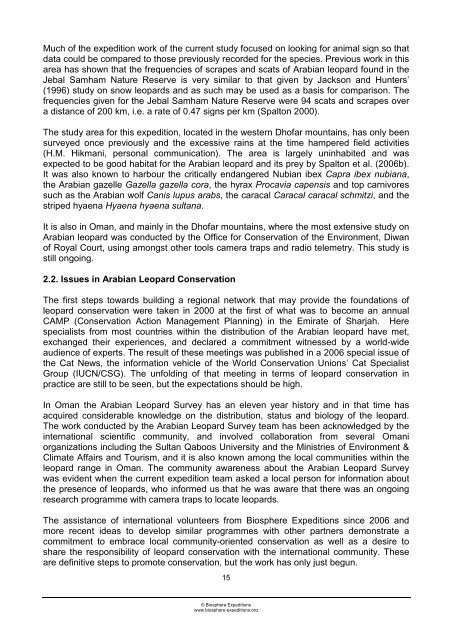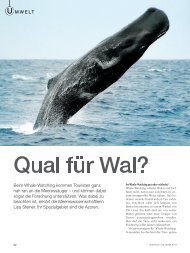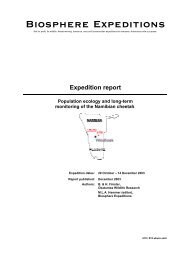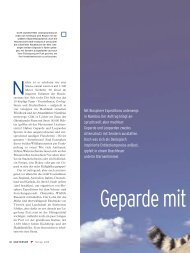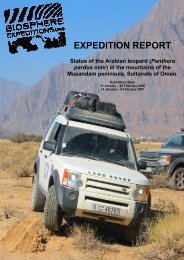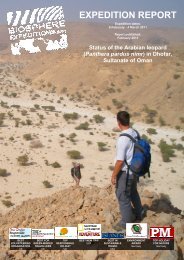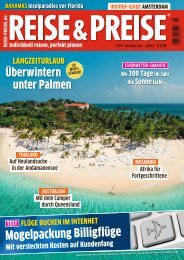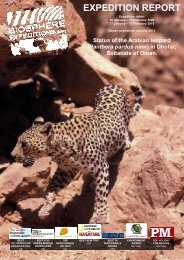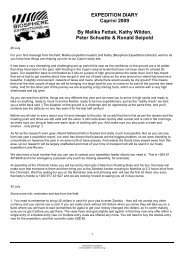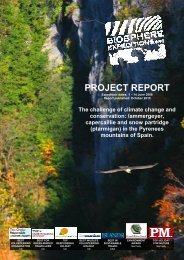Status of the Arabian leopard Panthera pardus nimr - Biosphere ...
Status of the Arabian leopard Panthera pardus nimr - Biosphere ...
Status of the Arabian leopard Panthera pardus nimr - Biosphere ...
Create successful ePaper yourself
Turn your PDF publications into a flip-book with our unique Google optimized e-Paper software.
Much <strong>of</strong> <strong>the</strong> expedition work <strong>of</strong> <strong>the</strong> current study focused on looking for animal sign so that<br />
data could be compared to those previously recorded for <strong>the</strong> species. Previous work in this<br />
area has shown that <strong>the</strong> frequencies <strong>of</strong> scrapes and scats <strong>of</strong> <strong>Arabian</strong> <strong>leopard</strong> found in <strong>the</strong><br />
Jebal Samham Nature Reserve is very similar to that given by Jackson and Hunters’<br />
(1996) study on snow <strong>leopard</strong>s and as such may be used as a basis for comparison. The<br />
frequencies given for <strong>the</strong> Jebal Samham Nature Reserve were 94 scats and scrapes over<br />
a distance <strong>of</strong> 200 km, i.e. a rate <strong>of</strong> 0.47 signs per km (Spalton 2000).<br />
The study area for this expedition, located in <strong>the</strong> western Dh<strong>of</strong>ar mountains, has only been<br />
surveyed once previously and <strong>the</strong> excessive rains at <strong>the</strong> time hampered field activities<br />
(H.M. Hikmani, personal communication). The area is largely uninhabited and was<br />
expected to be good habitat for <strong>the</strong> <strong>Arabian</strong> <strong>leopard</strong> and its prey by Spalton et al. (2006b).<br />
It was also known to harbour <strong>the</strong> critically endangered Nubian ibex Capra ibex nubiana,<br />
<strong>the</strong> <strong>Arabian</strong> gazelle Gazella gazella cora, <strong>the</strong> hyrax Procavia capensis and top carnivores<br />
such as <strong>the</strong> <strong>Arabian</strong> wolf Canis lupus arabs, <strong>the</strong> caracal Caracal caracal schmitzi, and <strong>the</strong><br />
striped hyaena Hyaena hyaena sultana.<br />
It is also in Oman, and mainly in <strong>the</strong> Dh<strong>of</strong>ar mountains, where <strong>the</strong> most extensive study on<br />
<strong>Arabian</strong> <strong>leopard</strong> was conducted by <strong>the</strong> Office for Conservation <strong>of</strong> <strong>the</strong> Environment, Diwan<br />
<strong>of</strong> Royal Court, using amongst o<strong>the</strong>r tools camera traps and radio telemetry. This study is<br />
still ongoing.<br />
2.2. Issues in <strong>Arabian</strong> Leopard Conservation<br />
The first steps towards building a regional network that may provide <strong>the</strong> foundations <strong>of</strong><br />
<strong>leopard</strong> conservation were taken in 2000 at <strong>the</strong> first <strong>of</strong> what was to become an annual<br />
CAMP (Conservation Action Management Planning) in <strong>the</strong> Emirate <strong>of</strong> Sharjah. Here<br />
specialists from most countries within <strong>the</strong> distribution <strong>of</strong> <strong>the</strong> <strong>Arabian</strong> <strong>leopard</strong> have met,<br />
exchanged <strong>the</strong>ir experiences, and declared a commitment witnessed by a world-wide<br />
audience <strong>of</strong> experts. The result <strong>of</strong> <strong>the</strong>se meetings was published in a 2006 special issue <strong>of</strong><br />
<strong>the</strong> Cat News, <strong>the</strong> information vehicle <strong>of</strong> <strong>the</strong> World Conservation Unions’ Cat Specialist<br />
Group (IUCN/CSG). The unfolding <strong>of</strong> that meeting in terms <strong>of</strong> <strong>leopard</strong> conservation in<br />
practice are still to be seen, but <strong>the</strong> expectations should be high.<br />
In Oman <strong>the</strong> <strong>Arabian</strong> Leopard Survey has an eleven year history and in that time has<br />
acquired considerable knowledge on <strong>the</strong> distribution, status and biology <strong>of</strong> <strong>the</strong> <strong>leopard</strong>.<br />
The work conducted by <strong>the</strong> <strong>Arabian</strong> Leopard Survey team has been acknowledged by <strong>the</strong><br />
international scientific community, and involved collaboration from several Omani<br />
organizations including <strong>the</strong> Sultan Qaboos University and <strong>the</strong> Ministries <strong>of</strong> Environment &<br />
Climate Affairs and Tourism, and it is also known among <strong>the</strong> local communities within <strong>the</strong><br />
<strong>leopard</strong> range in Oman. The community awareness about <strong>the</strong> <strong>Arabian</strong> Leopard Survey<br />
was evident when <strong>the</strong> current expedition team asked a local person for information about<br />
<strong>the</strong> presence <strong>of</strong> <strong>leopard</strong>s, who informed us that he was aware that <strong>the</strong>re was an ongoing<br />
research programme with camera traps to locate <strong>leopard</strong>s.<br />
The assistance <strong>of</strong> international volunteers from <strong>Biosphere</strong> Expeditions since 2006 and<br />
more recent ideas to develop similar programmes with o<strong>the</strong>r partners demonstrate a<br />
commitment to embrace local community-oriented conservation as well as a desire to<br />
share <strong>the</strong> responsibility <strong>of</strong> <strong>leopard</strong> conservation with <strong>the</strong> international community. These<br />
are definitive steps to promote conservation, but <strong>the</strong> work has only just begun.<br />
15<br />
© <strong>Biosphere</strong> Expeditions<br />
www.biosphere-expeditions.org


